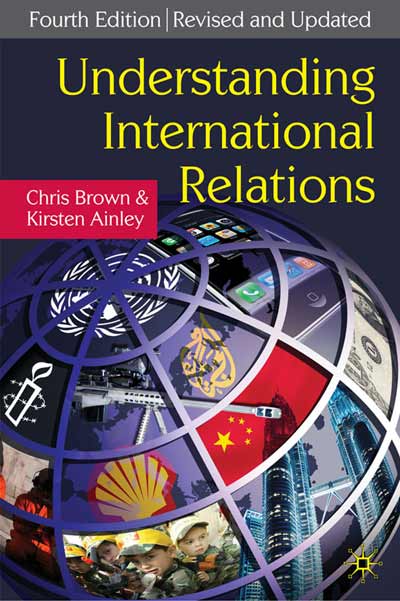Perspectives On International Relations Pdf
International relations theories come in a variety of forms, and this chapter will introduce three general theories and one newer perspective. Theory and the Levels of Analysis. In a categorization first used by Kenneth Waltz, three different sources of explanations are offered.
- What Is International Relations
- Perspectives On International Relations Power Institutions And Ideas Pdf
What Is International Relations
Nau’s bestselling book Perspectives on International Relations is admired for its even-handed presentation of realism, liberalism, constructivism, and critical theory―and for expertly applying those perspectives in every chapter. Students focus on the ways the different perspectives shape our understanding of the root causes of historical events and current controversies in world affairs, and learn to think critically about the world’s most urgent issues. In the new fifth edition, updates include the rise of ISIS, new developments in Russia, China and the Middle East, ongoing environmental concerns and more. Instructors will find a new 'primer' for students on how to learn to identify the perspectives and levels of analysis in the introduction and chapter one.
'synopsis' may belong to another edition of this title. About the Author: Henry R.
Nau has taught political science for nearly fifty years. He is currently professor of political science and international affairs at the Elliott School of International Affairs, George Washington University. He taught previously at Williams College and held visiting appointments at Johns Hopkins School of Advanced International Studies, Stanford University, and Columbia University. From 1989 to 2016, he directed the U.S.–Japan–South Korea Legislative Exchange Program, semiannual meetings among members of the U.S. Congress, the Japanese Diet, and the South Korean National Assembly.
In 2016, the Japanese government awarded him the Order of the Rising Sun, Neck Ribbon with Gold Rays, the highest honor for academic leaders, in recognition of his work on this Exchange.Nau also served in government twice, once from 1975 to 1977 as special assistant to the undersecretary for economic affairs in the U.S. Department of State and again from 1981 to 1983 as a senior staff member of the National Security Council under President Reagan, responsible for international economic affairs. He was the White House aide, or Sherpa, for the annual G7 economic summits in Ottawa (1981), Versailles (1982), and Williamsburg (1983), and for the special summit with developing countries in Cancun (1982). He is a former member of the UN Committee for Development Planning and the U.S. Department of State’s Advisory Committee on International Investment.

From 1977 to 1981, Nau served on the Board of Editors of the journal International Organization. He has received research grants from, among others, the Woodrow Wilson International Center for Scholars, the National Science Foundation, the Council on Foreign Relations, the Smith-Richardson Foundation, the Century Foundation, the Japan-U.S.
Friendship Commission, the Hoover Institution, the Rumsfeld Foundation, and the Lynde and Harry Bradley Foundation. From 1963 to 1965, he served as a lieutenant in the 82nd Airborne Division at Fort Bragg, North Carolina. Nau’s published books include, among others, Conservative Internationalism: Armed Diplomacy under Jefferson, Polk, Truman, and Reagan (Princeton University Press, 2013, and paperback with new preface, 2015); At Home Abroad: Identity and Power in American Foreign Policy (Cornell University Press, 2002); Trade and Security: U.S. Policies at Cross-Purposes (American Enterprise Institute, 1995); The Myth of America’s Decline: Leading the World Economy into the 1990s (Oxford University Press, 1990); and National Politics and International Technology: Peaceful Nuclear Reactor Development in Western Europe (Johns Hopkins University Press, 1974). His most recent edited book is Worldviews of Aspiring Powers: Domestic Foreign Policy Debates in China, India, Iran, Japan, and Russia, coedited with Deepa M. Ollapally (Oxford University Press, 2012).
Perspectives On International Relations Power Institutions And Ideas Pdf
Recent articles and chapters in edited books include “Trump’s Conservative Internationalism,” National Review, August 2017; “America’s International Nationalism,” American Interest, January/February 2017; “The Difference Reagan Made,” Claremont Review of Books, Winter 2016–2017; “How Restraint Leads to War: The Real Danger of the Iran Deal,” Commentary (July/August, 2015); “Ideas Have Consequences: The Cold War and Today,” International Politics 48 (July/September 2011): 460–81; “No Alternative to ‘Isms,’” International Studies Quarterly 55, no. 2 (June 2011): 487–91; “The ‘Great Expansion’: The Economic Legacy of Ronald Reagan,” in Reagan’s Legacy in a Transformed World, edited by Jeffrey L. Chidester and Paul Kengor (Harvard University Press, 2015); “Scholarship and Policy-Making: Who Speaks Truth to Whom?,” in The Oxford Handbook of International Relations, edited by Christian Reus-Smit and Duncan Snidal (Oxford University Press, 2008); and “Iraq and Previous Transatlantic Crises: Divided by Threat, Not Institutions or Values,” in The End of the West? Crisis and Change in the Atlantic Order, edited by Jeffrey Anderson, G. John Ikenberry, and Thomas Risse (Cornell University Press, 2008). Review: 'The strength of this text is that it does a good job of taking various perspectives and carrying them through a variety of different topics that we analyze in the study of international relations.